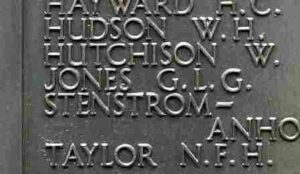Tabernacl Chapel was the fourth to be built on the site and was opened in August 1880. After its closure in 2002 the empty chapel suffered a fire on the 5 July 2008 that led to its demolition a few days later on 11 July. The war memorial that stood at the front of the chapel in Powell Street was fortunately spared and removed for safe keeping to Ceredigion Museum. The statue was the work of the eminent Italian sculptor, Professor Mario Rutelli of Palermo, at a cost of £500. It depicts a bronze figure alighting on earth bringing news of victory and peace to all. It was unveiled on 6 July 1921. A further plaque was added in 1946 commemorate the members of the chapel who fell during WW2. Professor Rutelli was given further commissions in the town, producing the statue of Edward Prince of Wales for the University, its Chancellor at the time, and the town memorial on castle point.
The Great War, 1914-1918
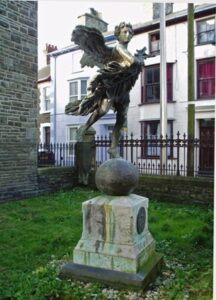
David Rees Davies, Sergeant, 14400, Kings Shropshire Light Infantry. David was the son of Aberystwyth Councillor David Davies, and of Eliza Jane Davies, and was employed at Lloyds Bank. He played football for Aberystwyth Town FC at centre forward. David joined the 7th Battalion, Kings Shropshire Light Infantry along with his close friend Edward David Evans on the same day in September 1914. The battalion was attached to 76 Brigade, 25th Division, and landed at Boulogne on 28 September 1915. On 15 October 1915 the Brigade moved to the 3rd Division, and on 19 October 1915 the battalion transferred to 8 Brigade in the same Division. In 1915 the Division saw action at Bellewaarde and Hooge, and took part in the Second attack on Bellewaarde. In 1916 the Division fought at the Actions of the Bluff, and at the St Eloi Craters. On 1 May 1916 David had volunteered to take up a forward position in the front line at Dickebusch. Sadly, the position was hit by shellfire, mortally wounding David. He died of his wounds that same day, before he could be taken to a dressing station. David was 23 years old, and is buried in La Clytte Military Cemetery, Belgium.
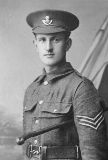
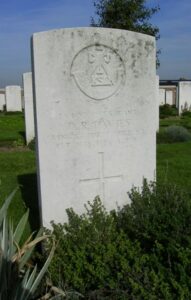
John Humphrey Edwards, Private, 19958, Royal Fusiliers. John was the son of John Humphrey Edwards and Mary Edwards, of Arlwyn, Llanbadarn Road, Aberystwyth. He enlisted at Chester into the 26th (Bankers) Battalion, Royal Fusiliers, which was attached to 124 Brigade, 41st Division. The Division moved to France by 6 May 1916, and began trench familiarisation in the Ploegsteert sector, south of Ypres. They remained here until August 1916, when they moved to the Somme, and took part in the Battle of Flers-Courcelette. The Division remained in the line, pushing on to Courcelette over the next few days before coming out for a rest and re-fit. They then fought at the Battle of Le Transloy, before moving to positions south of Ypres in 1917. John was on guard duty at a junction in the trench on 1 May 1917, when a shell exploded nearby causing severe wounds from which he died that same day. He was 26 years of age and is buried at Dickebusch New Military Cemetery, Belgium.
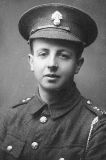
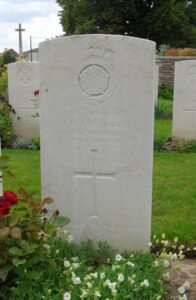
David Henry Felix, Private, 33024, Welsh Regiment. David was the son of David and Margaret Felix, 4, Edge Hill Road, Aberystwyth. A loyal member of Tabernacl Chapel, he was educated at Alexandra Road School. David enlisted at Pontypridd into the Welsh Regiment, and was posted to France on 22 June 1915, joining the 1st Battalion, Welsh Regiment, which was attached to 84 Brigade, 28th Division. David joined the battalion during the tail end of the Second Battle of Ypres, and was posted to D Company. The battalion was stationed in the Locre area when David was killed in action on 9 August 1915. He was 19 years old, and is buried at Kemmel Chateau Military Cemetery, Belgium.
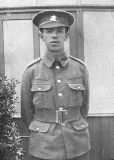
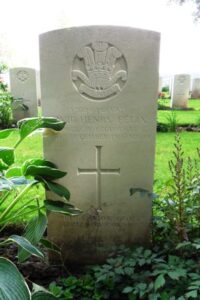
James John Herbert Howard, Lance Corporal, 19963, Royal Welsh Fusiliers. James was born in 1892, the son of Margaret Howard, of Mill Street, Aberystwyth. He was a faithful member of Tabernacl Chapel Sunday School and played football for Aberystwyth Town FC prior to the war. James originally enlisted at Aberystwyth into the 9th Welsh, but transferred to the 16th Battalion, Royal Welsh Fusiliers, which was attached to 113 Brigade, 38th (Welsh) Division. The Division had landed in France during December 1915 and had spent their first winter in the trenches near Armentieres. In June they marched south to the Somme, where they were tasked with the capture of Mametz Wood. The attack on the wood began on 7 July, but met with fierce resistance, and it took until 14 July to totally clear the wood. James suffered serious injuries to his leg and arm when a shell exploded near to him during the assault on Mametz Wood. Capt G D Ellis, his senior officer in the 16th RWF informed his parents that “there was little room to hope that he would recover”. James died on 12 July 1916, aged 23, and was buried in Carnoy Military Cemetery, France.
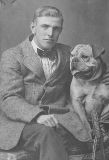
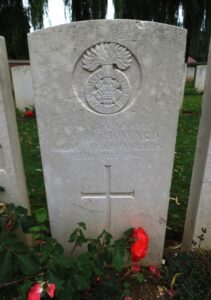
John Hugh Joel, Private, 37458, Machine Gun Corps. John was born in 1883, the son of Abraham and Elizabeth Joel, of Green Gardens, Aberystwyth. He resided at Llanwonno prior to the war, and in March 1916 enlisted at Tredegar into the Royal Welsh Fusiliers. John was later transferred into the 4th Company, Machine Gun Corps, which was attached to the 16th (Irish) Division. John’s machine gun team was in action at Ypres when he was struck by a shell splinter and killed on 16 August 1917, aged 34. He was buried in a small cemetery near Ypres, but his grave was subsequently lost during further fighting in the area, and he is now commemorated on the Tyne Cot Memorial, Belgium.
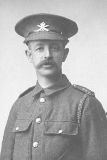
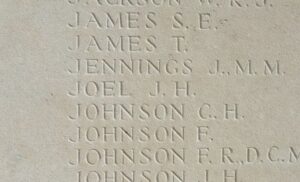
Evan Richard Jones, Private, 320242, Welsh Regiment. Evan was born in 1893, the son of Evan J. Jones and Anne Jones, of 3, Spring Gardens, Trefechan, Aberystwyth. He had originally served with the Pembroke Yeomanry. During March 1916 the 1/1st Pembroke Yeomanry moved to Egypt, where it merged with the Welsh Border Mounted Brigade and formed the 4th Dismounted Brigade. On 2 February 1917 it merged with the 1/1st Glamorgan Yeomanry to form the 24th Battalion, Welsh Regiment, and became attached to 231 Brigade, 74th (Yeomanry) Division. The Division had formed in Egypt in January 1917 and had fought through the Palestinian Campaign, at the Battles of Gaza and the Battle and capture of Jerusalem. Evan was killed in action at Beersheba on 6 November 1917. He was 24 years old, and is buried at Beersheba War Cemetery, Israel.
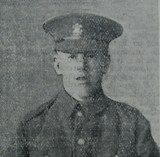
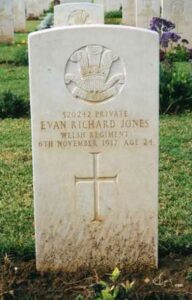
Trevor Jones, Private, 370072, Royal Army Medical Corps. Trevor was the son of Hugh and Charlotte Jones, of Broncoed, Crosswood. He enlisted at Cardiff into the Royal Army Medical Corps, and was posted to the 53rd Welsh Casualty Clearing Station, Royal Army Medical Corps, which was attached to the 53rd (Welsh) Division. The 53rd (Welsh) Division sailed from Devonport in July 1915, and arrived at Mudros on 5 August 1915. From here they moved to Gallipoli, landing on 9 August 1915. Here the Division was immediately thrown into action, and spent the next few days in isolated pockets, fighting against a Turkish counter-attack during the Battle of Sari Bair, then the ensuing Attack on Scimitar Hill. The Division remained here throughout the coming months, and suffered severe losses in manpower strength during the great November 1915 blizzard on Gallipoli, when its total strength was reduced to less than that of a full-strength Brigade. On 11 December 1915 the Division was evacuated to Mudros, and by 23 December 1915 were moved to Egypt. They remained on the Suez Canal Defences for the next twelve months, and in early 1917 moved into Palestine. Trevor was wounded during the First Battle of Gaza, and evacuated to hospital at Cairo, where he died of his wounds on 13 May 1917. He was 22 years old, and is buried at Cairo War Memorial Cemetery, Egypt.
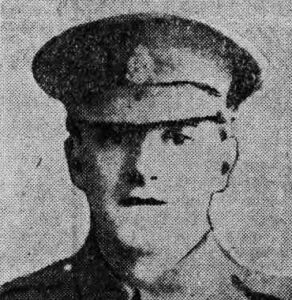
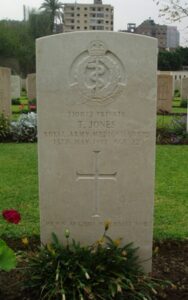
William Jones, Rifleman, 653423, London Regiment. William was the husband of Catherine Jones of 58 Terrace Road, Aberystwyth and was a faithful member of Tabernacl Chapel. He enlisted at Camberwell into the 21st Battalion, London Regiment (1st Surrey Rifles), which was attached to 142 Brigade, 47th (2nd London) Division. The Division fought at the Battle of Aubers, and the Battle of Festubert during May 1915 and in September fought at the Battle of Loos, and subsequent Action of Hohenzollern Redoubt. They were north of Arras when the Germans attacked Vimy Ridge, and then moved south to the Somme, where they fought at the Battle of Flers-Courcelette, and then at the Battle of Le Transloy, where the Division captured Eaucourt l’Abbe, and took part in Attacks on the Butte de Warlencourt. Early in 1917 the Division moved north to Belgium, and took part in the Battle of Messines. William was wounded soon after the move to Belgium, and died of his wounds on 18 May 1917, aged 40. William is buried in Bedford House Cemetery, Belgium.
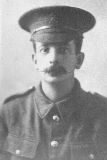
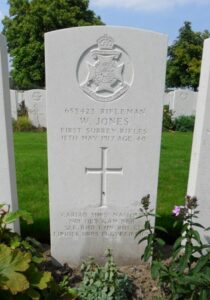
Richard William Millman, Gunner, 168400, Royal Field Artillery. Richard was born on 1 September 1892, the son of Henry and Sarah J. Millman, of 3, Harbour Terrace, Trefechan, Aberystwyth. Richard worked for the Great Western Railway prior to the war, and was a pre-war territorial, reporting for duty with the Cardigan Battery, Royal Field Artillery on 5 August 1914. Richard was posted to the Guards Trench Mortar Battery, Royal Field Artillery, which was attached to the Guards Division. The Guards Division had had a hard war. It fought at Loos in September 1915, and in 1916 fought at the Somme. In 1917 the Guards fought at Third Ypres, and at the Battle of Cambrai. During 1918 the Division had fought against the German offensive on the Somme, and later that year took part in the great advance to victory, ending up at Maubeuge at the Armistice. Richard survived the war, but died of influenza on 6 December 1918 at the 4th Casualty Clearing Station. He was 26 years old, and is buried in Solesmes British Cemetery, France.
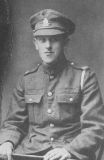
Robert Owen, Private, 61496, Royal Welsh Fusiliers. Robert was born at Dolgellau on 6 November 1884. He enlisted into the 3rd Royal Welsh Fusiliers at Cardiff on 19 April 1917, his papers noting that he was of no fixed abode, and that he had previously served with the 3rd Monmouths. On 22 April 1917 Robert was posted to the 16th Battalion, Royal Welsh Fusiliers, which was in France attached to 113 Brigade, 38th (Welsh) Division. He served with the battalion in France until becoming discharged as medically unfit on 31 October 1917, after having suffered epileptic fits after being gas poisoned. Robert died on 27 March 1918, aged 33 in sad circumstances. He was to be buried at the expense of the Poor Law Guardians but an appeal through the YMCA ensured he was given a heroes funeral with full military honours in Aberystwyth Municipal Cemetery. His headstone also commemorates an unknown seaman of the Great War who is buried with him.
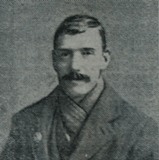
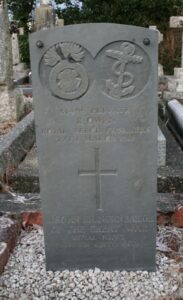
Henry Morgan Richards, Private, 31742, Welsh Regiment. Henry was the son of Morgan and Mary Anne Richards, of 6, Little Dark Gate Street, Aberystwyth. He enlisted at Aberystwyth into the 15th Battalion, Welsh Regiment, which was known as the Carmarthen Pals battalion, attached to 114 Brigade, 38th (Welsh) Division. On 2 December 1915 the battalion moved to France, and the entire Division moved to the Fleurbaix sector, where it was initiated into trench warfare. During June 1916 the Division marched south to the Somme, and on 7 July 1916 attacked Mametz Wood. The initial attack failed, and it was three days later, on 10 July, that a fresh attack was mounted. After two days of heavy hand to hand fighting within the wood, the Germans withdrew, and the battered Welshmen moved via Hébuterne to Boesinghe, on the Yser Canal, where it remained until launching its attack on Pilckem Ridge on 31 July 1917. Henry was killed on 30 July 1917, on the eve of the attack on Pilckem Ridge. He was 39 years old, and is buried in Bard Cottage Cemetery, Belgium.
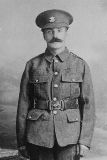
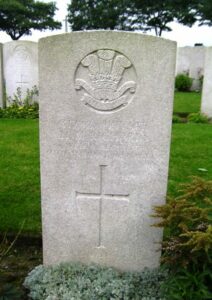
Evan David Rowlands, Lance Corporal, 19964, Royal Welsh Fusiliers. Evan was born in 1889, the son of Evan and Anne Rowlands, of 13, Bridge Street, Aberystwyth. He enlisted in 1914 into the Welsh Regiment, but was transferred to the 16th Battalion Royal Welsh Fusiliers. The battalion was attached to 113 Brigade, 38th (Welsh) Division, and landed in France on 2 December 1915, and had spent their first winter in the trenches near Armentieres. In June they marched south to the Somme, where they were tasked with the capture of Mametz Wood. The attack on the wood began on 7 July, but met with fierce resistance, and it took until 14 July to totally clear the wood. The Division suffered terrible casualties at Mametz, and were taken out of the line, and moved to Ypres to rebuild. Here they fought at the Battle of Pilckem Ridge, and the Battle of Langemarck. They then moved to Armentieres, where they remained from September 1917 until March 1918 when the German Spring Offensive was launched. The British had been over-run on the Somme, and in April the Division was moved South, taking up positions North of Albert, from where they weathered the storm of the coming months, until the war turned during the Battle of Amiens, on 8 August 1918. The Germans had now lost the upper hand, and the British regained the lost ground on the Somme after an attack which began on 21 August, with the 38th Welsh in the midst of the attack during the Battle of Albert, and then moving east, where they fought at the Battle of Bapaume. Then the move began towards the mighty Hindenburg Line, and the Division carried on with their march east, fighting at the Battle of Havrincourt, and the Battle of Epehy. A short rest period ensued, during which time the Canal du Nord was breached, so opening a passage through the Hindenburg Line. Evan was gassed during the fighting around the Canal du Nord, and was evacuated to Etaples for treatment. He then contracted influenza and pneumonia, and died at Etaples on 31 October 1918, aged 29. He is buried at Étaples Military Cemetery, France.
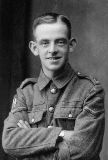
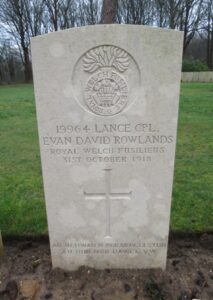
William Williams, Private, 4931, Australian Imperial Forces. William was the son of Daniel and Elizabeth Williams of 1, Williams Street, Aberystwyth. William was a sailor, and had emigrated to Australia at the age of fourteen, along with his brother, and prior to the war had married, residing with his wife, Sarah Ann Williams, at Freemantle, Western Australia. William enlisted at Blackboy Hill on 28 February 1916 into the 11th Battalion, Australian Infantry, and on 1 April 1916 left Fremantle aboard HMAT Ulysses, bound for Egypt. At Tel-El-Kebir, William’s group of reinforcements joined with veterans from Gallipoli to form the 51st Battalion, Australian Imperial Force, which became attached to the 13th Brigade, 4th Australian Division. Arriving in France on 12 June 1916, the 51st Battalion moved into the front line, and fought in its first major battle at Mouquet Farm in August and September 1916, suffering almost 30 percent casualties. The battalion saw out the rest of the year, alternating between front-line duty, and training and labouring behind the line near Flers during the bleak winter of 1916-17. Early in 1917, the battalion followed the German retreat to the Hindenburg Line, and on 2 April 1917 it attacked at Noreuil. Later in the year, the AIF moved to Ypres, and the 4th Division fought in the battle of Messines between 7 and 12 June, and the battle of Polygon Wood between 26 and 27 September. William was killed in action at Polygon Wood on 29 September 1917. His grave was never located, so William is commemorated on the Ypres (Menin Gate) Memorial, Belgium.
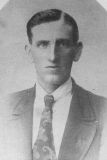
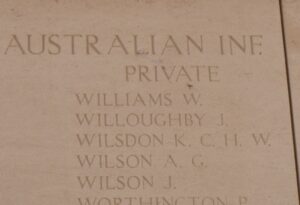
Albert Edward Young, Private, 1658, Welsh Guards. Albert was born in Llannon, but resided in the Police Station, Llandyssul prior to the war. He enlisted at Carmarthen into the 1st Battalion, Welsh Guards, which had been formed by Royal Warrant of 26 February 1915. They landed at Havre on 8 August 1915, where they were attached to 3 Guards Brigade, Guards Division. They saw their first action at the Battle of Loos the following month, and suffered terrible casualties before moving north to Ypres, where they were to remain until moving south to the Somme in July 1916 to take part in the Somme Offensive. Albert was wounded just before the Guards Division made their move to the Somme, on 1 July 1916. He was brought to the Base Hospital at Wimereux where he died of wounds on 10 July 1917. He was 21 years old, and is buried in Wimereux Communal Cemetery, France.
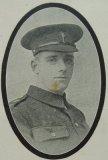
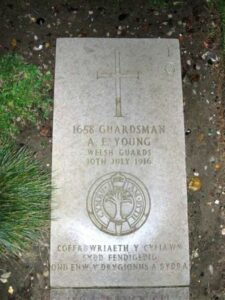
The Unveiling Ceremony of the Great War Memorial
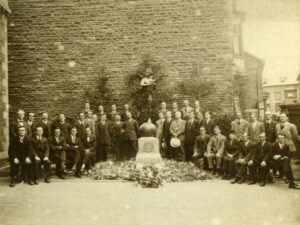
World War Two, 1939-1945
Meirion Edwards, Private, 4923315, South Staffordshire Regiment. Meirion was the son of John Griffyth Edwards and Alice Gwendolen Edwards, of Penparke, Aberystwyth. He served with the 1/6th Battalion, South Staffordshire Regiment, which was attached to the 59th (Staffordshire) Division. The division landed in Normandy as part of the Second Army on 26 June 1944, and was employed in the north-western outskirts of Caen, fighting against elements of the 12th SS Panzer Division. Meirion was killed in Normandy on 7 August 1944. He was 30 years old, and is buried in Ryes War Cemetery, Bazenville, France.
Thomas Brinley Edwards, Lance Serjeant, 984699, Royal Artillery. Brinley was born on 4 February 1914, the son of Hugh Jenkin Edwards, and of Anne Marie Edwards (nee Jones), of Aberystwyth, and had played football for Aberystwyth FC prior to the war. He served with 11 (Honourable Artillery Company) Regiment, Royal Artillery, which served in North Africa, equipped with Priest self-propelled guns. Brinley was taken prisoner after the fall of Tobruk, and was handed over to the Italians. He was among a number of POWs taken aboard the S.S. Scillin, which sailed from Tripoli for Italy on 14 November 1942. During the night the ship was torpedoed and sunk by the Royal Navy Submarine HMS Sahib, and 783 POWs drowned. Thomas was 28 years old when he died that night, and is commemorated on the Alamein Memorial, Egypt.
William Glynne Edwards, Lieutenant, Royal Navy. William was the son of William and Mary Lloyd Edwards, of Aberystwyth. He served with the Royal Navy aboard the destroyer HMS Harvester. In March 1943 whilst she was providing escort duties for convoy HX 228 in the Atlantic she forced U-444 to the surface before ramming her. Shortly after on 11 March 1943 she was herself torpedoed by U-432, breaking in half and sinking with the loss of 9 officers and 136 ratings. William was amongst those lost. He was 31 years old and is commemorated on the Chatham Naval Memorial, Kent.
Eric Glynn Evans, Major, 67683, Royal Artillery. Eric was the son of Ivor and Elizabeth Evans, of Aberystwyth. He served with the 146th (The Pembroke Yeomanry) Field Regiment, Royal Artillery. Reformed as field artillery during WW2, the Pembroke Yeomanry’s Cardiganshire Battery became a separate Regiment on the outbreak of the Second World War, and as 146th Field Regiment they landed in Suez in September 1942, joining the Eighth Army in time for the battle of El Alamein, forming part of the 7th Armoured Division. Eric was killed during the final stages of the Tunisian Campaign, on 26 April 1943. He was 25 years old, and is buried at Enfidaville War Cemetery, Tunisia.
Gwilym Louis Gobert Jones, Second Officer, Merchant Navy. Gwilym, who was known as Louis, was born on 6 May 1916, the son of Lieutenant Gwilym Jones and of Margaret Jones, of Aberystwyth. He served with the Merchant Navy aboard the SS Tymeric, a Glasgow registered steamer. On the morning of 23 November 1940, Tymeric was in convoy OB-244, carrying a cargo of coal from Hull to Buenos Aires, when she was hit by a torpedo from the German submarine U-123, and sank in flames with the loss of 71 lives. Louis was 24 years old when he died that day, and is commemorated on the Tower Hill Memorial, London.
